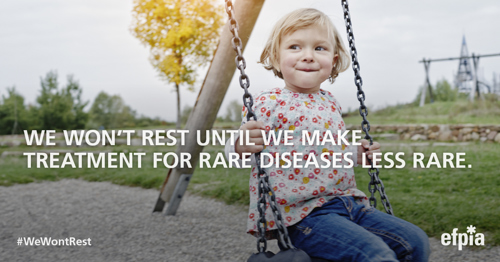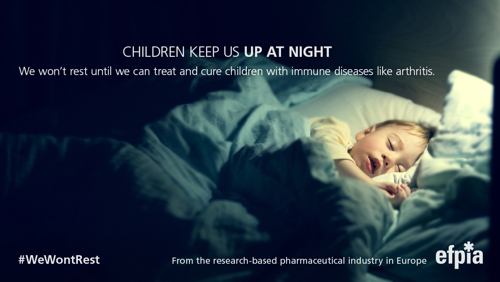Rare & childhood diseases: addressing unmet need
14.06.19
#WeWontRest until treatments for rare conditions and paediatric medicines become less rare
Most of us will know someone affected by rare disease. While each individual rare disease affects less than one in 2,000 people(1), there are more than 6,000 conditions classified as "rare" diseases. In Europe, they affect one in 17 people. This translates into around 30 million people in Europe.
Most of us will know someone affected by rare disease. While each individual rare disease affects less than one in 2,000 people(1), there are more than 6,000 conditions classified as "rare" diseases. In Europe, they affect one in 17 people. This translates into around 30 million people in Europe.
The term “rare disease” relates to thousands of individual conditions, including metabolic disorders, kidney disorders, skin conditions, rare cancers, epilepsies and many more, with some common characteristics. For example, a large proportion begin in childhood. Many rare diseases are associated with lifelong suffering and shorter life-spans: one in three children with a rare disease will die before their 5th birthday. And around 80% have a genetic component.
Talking to people living with rare diseases, perhaps the most common themes are the difficult journey they endure in search of a diagnosis, and their despair at the lack of treatment options. Patients can spend years seeing specialists, waiting for answers and hoping a diagnosis will open the door to a life-changing treatment.
However, diagnosis rarely results in an end to suffering. Rare disease patients may take comfort in having a diagnosis – not least if it helps them connect with other people living with the same condition – but the lack of therapeutic options can be a source of deep frustration. Until now, there are no licensed treatments for 95% of rare diseases.
There are a host of reasons for this. The small size of the patient populations makes it difficult to conduct clinical trials, and means that even if a potential treatment clears all clinical and regulatory hurdles (never an easy feat), it might be suitable for just a few hundred people. In addition, given that many rare diseases have a genetic component, the science involved can be extremely challenging as it requires an individual and personalised approach.
With other pressing unmet medical needs competing for attention, take dementia for example – an effective and predictable framework of incentives was and still is very much needed to support the development of new treatments for rare conditions.


Making an impact
This exceptionally challenging patient experience was recognised in the EU more than two decades ago, resulting in the introduction of the EU Orphan Medicines Regulation in 2000. The impact has been marked. Before the Regulation came into force, there were only eight authorised medicinal products to treat rare diseases. That is eight treatments out of more than 6,000 rare conditions.
Since its introduction, more than 160 orphan medicines have been authorised and the number of clinical trials focused on rare disease has grown by 88% in a decade (2006-2016). It’s a great case study in how the support of policy-makers and the appropriate policy and regulatory measures can transform the landscape and change patients’ lives in the process. Policy makers in Europe can be rightly proud of their contribution to the fight against rare diseases.
How was this achieved? The Regulation introduced a definition and specific criteria of designation for orphan medicinal products and the EMA established a specific committee in charge of orphan medicines, the Committee for Orphan Medicinal Products (COMP). In addition, certain incentives were introduced to stimulate development of treatments for rare diseases, including; help with designing clinical trials, access to the centralised procedure for one-stop marketing authorisation in all EU Member States, a system of reduced fees for regulatory procedures; and a 10-year market exclusivity for successfully authorised orphan medicines.
Acknowledging the challenges in providing highly specialized treatment or care for patients who have complex conditions like rare diseases, European Reference Networks (ERNs) were approved by the European Commission in 2017, providing a unique opportunity for clinicians to work cross border in Europe in order to tackle this challenge.
The above, coupled with scientific advances, triggered a wave of new treatment options for rare diseases patients. Many of the new products use breakthrough technologies, from cell and gene therapies to monoclonal antibodies, to target disease sites. With the right regulatory environment, these scientific advances will continue to reach patients with rare diseases.
There has been significant progress and much more remains to be done to ensure that no one living with a rare disease is left behind.
Paediatric Regulation
The power of regulations to deliver for patients can also be seen in the field of paediatric medicines. The EU Paediatric Medicines Regulation came into force in 2007. This Regulation made it mandatory to study most new medicines in children as well as adults, and where needed to develop formulations of those medicines suitable for children. In return, the regulation provided certain rewards for doing this paediatric R&D work, including a limited additional period of exclusivity for eligible products.
Prior to 2007, an estimated 50% of medicines had not been tested and developed for use in children. That has been changing, fast. Over the past decade or so, we’ve seen real progress in paediatric research and this investment is starting to bear fruit. Since symptoms of 50% of rare diseases begin in early life, children with rare diseases have benefited significantly from this regulation too.
In the past ten years, over 260 new medicines and indications for treating children have been approved in Europe. That means children with debilitating diseases including HIV, cancer, Hepatitis C and rheumatoid arthritis now have treatment options where previously there were none.
More progress is on the horizon: the number of paediatric investigation plans is rising, and more clinical trials are ongoing. The proportion of paediatric clinical trials has increased by 50% (from 8.25% to 12.4% of all trials conducted in the EU).


A new era
A new generation of researchers has come of age in an era where paediatric clinical research is driven and supported by EU regulation. This will pay off for decades to come, provided that the regulatory environment remains dynamic and open to innovation, bottlenecks are unblocked, and there are continuous experience-sharing and knowledge exchanges between researchers. This is an area where projects in the Innovative Medicines Initiative (IMI) have been helping by, for example, creating a pan- European Paediatric Clinical Trials Network (IMI C4C project) to help the running of clinical trials for children and ensure that the voices of young patients and their families are heard.
Despite all the progress made since the regulatory ecosystem for rare diseases and paediatric medicines were reimagined, we mustn’t lose sight of the fact that most children and patients with rare diseases still have little hope of treatment. Our work is far from finished.
Conducting R&D in children is a well-known challenge, not least because there are a limited number of young patients that can be included in clinical studies. As we consider how to overcome this, we must embrace the bold spirit that helps unlock the potential in orphan and paediatric medicines.
Studying children’s cancers on a global scale would help broaden the patient pool and accelerate progress. This will require action to enhance alignment between regulatory systems. Use of data and new trial design can be equally pivotal in boosting research.
Embracing innovative approaches that support the development of modelling and simulation, deployment of digital health tools, as well as alternatives to randomised clinical trials such as real world evidence and the use of remote clinical trials may be avenues to help further develop this area.
The role of the Orphan and the Paediatric Regulation will be discussed at a conference organised by the European Commission “Medicines for rare diseases and children: learning from the past, looking to the future”. While we recognise that there is much still to do if we are to address unmet medicinal need, Europe’s success in orphan medicines and paediatric medicines should give us reason to persevere. With the right framework in place we can continue to work together to meet the needs of children and adults living with a rare disease. As an industry #WeWontRest until treatments for rare conditions and paediatric medicines become less rare.
